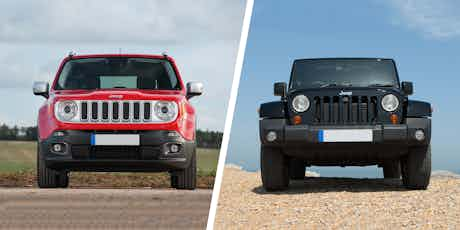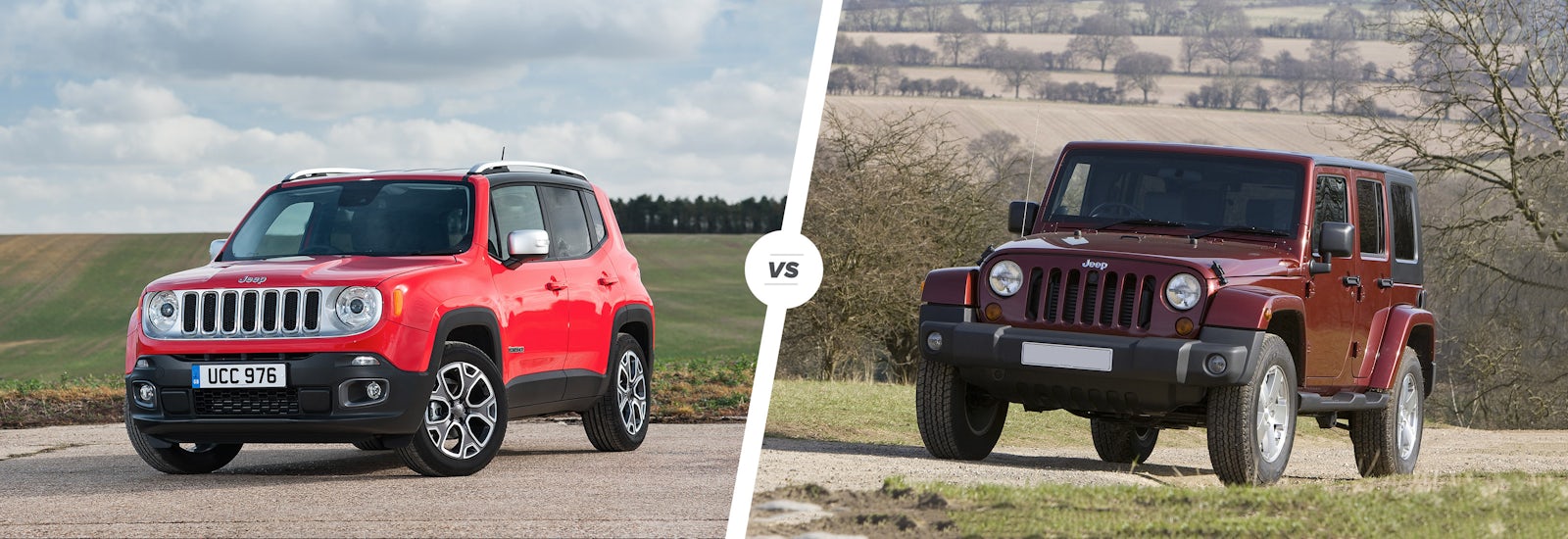Jeep Renegade vs Wrangler: seven bar battle
October 13, 2015 by carwow staff

Jeep is well known the world over for building big, tough 4×4 vehicles. Big in off-road ability, small in complication, a tough four-wheel drive system and powerful engines help its models to compete with some of the most capable off roaders on sale today – in the rough stuff at least.
The Wrangler is perhaps the epitome of this formula: chunky, simple and with character that is found wanting in many modern alternatives, it’s far more at home rolling up its sleeves and getting mucky than it is performing the school run.
There’s a much greater demand for cars which are more comfortable on the road, though, which is why Jeep has produced the Renegade (shown on the left in all our comparison photos). Co-developed with Fiat (it shares its platform and several engines with the 500X), it’s aimed as a more rugged alternative to the likes of the Nissan Juke and Skoda Yeti.
If you have your heart set on a Jeep, which is the one to have? We’ve compared the pair side-by-side to find out.

Styling

The compact crossover class arguably boasts a wider variation in styling among its competitors than any other market segment. From the wacky-looking Juke to the simple-looking Suzuki Vitara, there is a huge amount of diversity. The Jeep Renegade falls closer to the Suzuki than the Juke in terms of styling – it’s designed to appeal to those who might indulge in an occasional off-road excursion.
There are plenty of neat touches dotted around the Renegade – from the signature seven-bar grille to the tow hooks painted bright red (it makes them easier to spot in the mud) it all adds up to a fairly pleasing design.
The Wrangler wasn’t so much styled, as engineered to be capable off road, with few other concessions. Huge, square wheel arches allow the wheels to make the most of long suspension travel, while the ground clearance is high enough to allow it to wade through 483mm of water. Opt for one of the soft-top models, and the windscreen can hinge forwards, giving the driver an even better view of potential obstacles ahead.
Two body styles are available: the two-door version is short and compact (it measures 7mm shorter than the Renegade), while the four-door Wrangler adds 523mm between the front and rear wheels to increase cabin space. Regardless of the body shape, it undeniably boasts plenty of character.
Interior

Slip behind the wheel of the Renegade, and drivers are greeted with a fairly contemporary-looking dash. It still has chunky knobs and switches that buyers expect from a Jeep, but little touches like the colour-coded air vents and speaker surrounds help to liven things up a bit.
It isn’t a big car overall, so don’t expect vast reserves of legroom in the rear. It is, however, reasonable for the compact crossover class it competes in, as is the 351-litre boot volume.
The Wrangler has been improved recently with the addition of more modern switchgear, steering wheel designs and interior trim. While the dash layout is fairly clear and logical, it’s much closer to a utilitarian Land Rover Defender than a modern SUV in terms of aesthetic appeal. It does feel very hard-wearing though – the sort of car which you’d be tempted to hose down whenever it gets a little grubby.
Choose the two-door Wrangler, and practicality is desperately poor – rear legroom is minimal, and the boot measures a tiny 142 litres. With its 498-litre boot and easier access to the back seats, the four-door is the better bet.
Driving

This is where the biggest differences between the two lie. When it comes to the driving experience, the decision comes down to whether you’d prefer a car to prioritise off-road ability or on-road civility.
The Renegade delivers the latter. Grip is strong and the suspension is firm so body roll isn’t excessive. Some testers would argue that it’s too firm – there have been complaints that the ride never quite settles down as nicely as you’d hope. This can be remedied by opting for the top-spec Trailhawk model because its larger tyres help to add some extra cushioning to the ride. For it’s class it’s quite capable off-road – as long as you opt for one of the four-wheel drive models – though it isn’t a match for the Wrangler.
The Renegade’s older brother is a 4×4 in the true sense – point it towards the nearest muddy trail and it’s relish the challenge. It delivers strong traction on difficult surfaces, and there’s plenty of articulation from the suspension, allowing it to clamber over all manner of jagged, rocky surfaces.
On the road, the story isn’t quite so good. The steering is as vague as it is lifeless and it feels far too roly-poly in the corners. At least it’s fairly comfortable.
Engines

As with the driving experience, the engine choices vary wildly between the pair. The Renegade’s units are primarily designed to offer a blend of economy and refinement. The Wrangler’s on the other hand, are big, torquey, and aim to deliver as much low down grunt as possible in order to help it traverse difficult terrain.
The Renegade range shares several engines with the Fiat 500X, and one of the most popular in the range is likely to be the 1.4-litre ‘MultiAir’ petrol unit. The turbocharged motor sends 138 horsepower through the front wheels, and delivers adequate performance and impressive refinement. Those looking for a little more pulling power can opt for the 168hp 2.0-litre turbodiesel – available with four wheel drive only, it’ll reach 62mph from rest in 8.9 seconds and average a claimed 48.7mpg.
If torque and strength are important, then the Wrangler is the car to have. Two engine choices are available: a 2.8-litre diesel or a 3.6-litre V6 petrol. The former delivers 339lb ft of torque from just 1,600rpm, while the 280hp petrol will heave even the larger four-door model from 0-62mph in only 8.1 seconds. Despite the standard fitment of stop/start technology, fuel economy is dire – the official figures for the 2.8 diesel are rated at an optimistic 34.9mpg, or 12.2mpg worse than even the most thirsty petrol Renegade.
If you’re after a modern engine with decent fuel economy, then the Renegade is the best choice here.
Value for money

Compare the two versions at a similar price point and the Renegade appears to offer far more for the money. The four-wheel-drive, 2.0-litre diesel Trailhawk version of the Renegade costs just under £28,000 – more than £1,000 cheaper than the entry-level two-door diesel Wrangler. Considering how much cheaper it will be to fuel, insure and tax, the Renegade appears to be the more sensible choice by some considerable margin.
The Renegade is also far safer: thanks to its six airbags and lane departure warning and collision warning systems, it achieved the maximum five-star rating when assessed by Euro NCAP. The Wrangler was designed at a time when there wasn’t such a thing as a ‘crumple zone’ let alone autonomous city braking. Safety tech only extends as to a pair of airbags and some Isofix child-seat mounting points in the rear.
Verdict

Picking a winner here is fairly straightforward: if you will be buying a car that will spend more time off road than on it, buy the Wrangler. For almost any other practical or rational reason, get the Renegade. It’s safer, more comfortable, better to drive on the road, cheaper to run and – relative to the two-door Wrangler at least – is significantly more practical, too.















